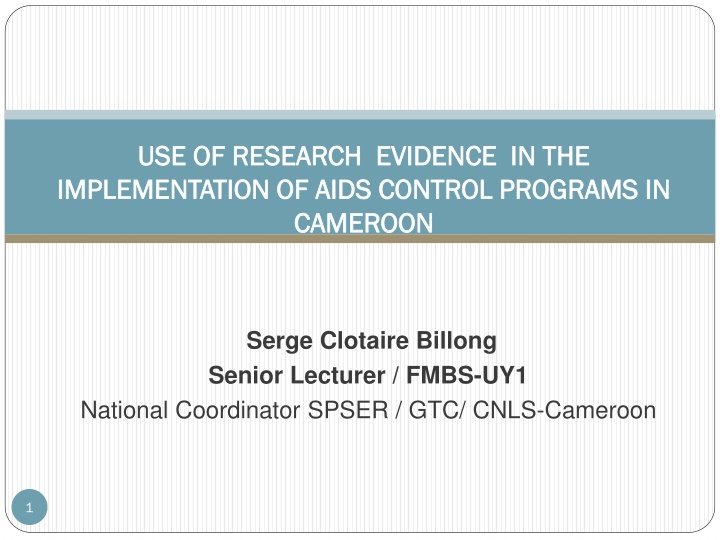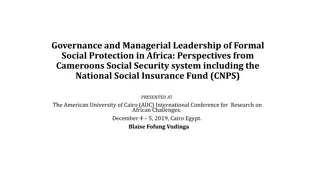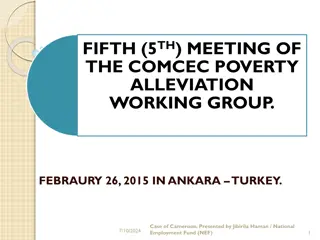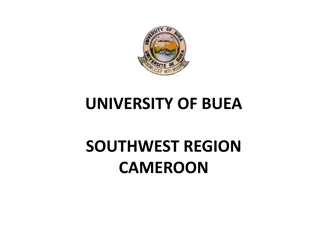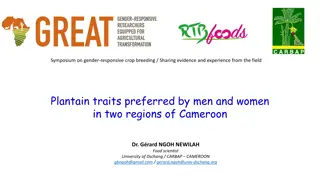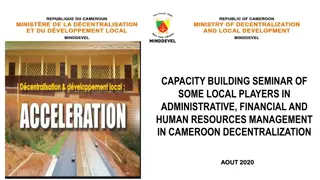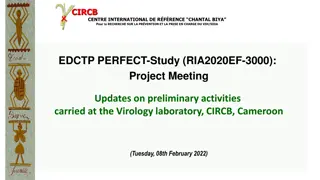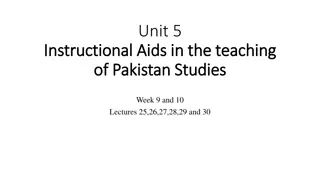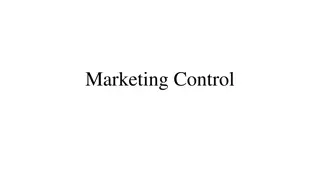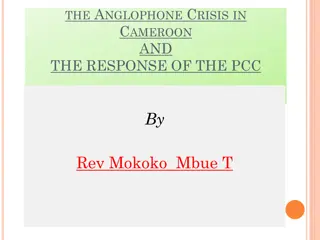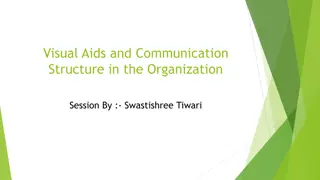Research Evidence in AIDS Control Programs in Cameroon
The use of research evidence in implementing AIDS control programs in Cameroon, focusing on data as a basis for prevention, care, and treatment initiatives. The country profile, stakeholders, and domains of HIV research are highlighted, emphasizing the importance of reliable research data in decision-making processes.
Download Presentation

Please find below an Image/Link to download the presentation.
The content on the website is provided AS IS for your information and personal use only. It may not be sold, licensed, or shared on other websites without obtaining consent from the author.If you encounter any issues during the download, it is possible that the publisher has removed the file from their server.
You are allowed to download the files provided on this website for personal or commercial use, subject to the condition that they are used lawfully. All files are the property of their respective owners.
The content on the website is provided AS IS for your information and personal use only. It may not be sold, licensed, or shared on other websites without obtaining consent from the author.
E N D
Presentation Transcript
USE OF RESEARCH EVIDENCE IN THE USE OF RESEARCH EVIDENCE IN THE IMPLEMENTATION OF AIDS CONTROL PROGRAMS IN IMPLEMENTATION OF AIDS CONTROL PROGRAMS IN CAMEROON CAMEROON Serge Clotaire Billong Senior Lecturer / FMBS-UY1 National Coordinator SPSER / GTC/ CNLS-Cameroon 1
AGENDA INTRODUCTION Country Profile / HIV summary data Domains and stakeholders of HIV and AIDS research in Cameroon USE of DATA as evidence-base for prevention, care and treatment programs CONCLUSION 2
INTRODUCTION / COUNTRY PROFILE Central Africa: 24 000 000 inhabitants 2,7% prevalence of HIV(DHS 2018) 500 000 PLWHIV Prevalence of HIV among MSM: 20,6%(2016) Prevalence of HIV among sex workers: 24,3%(2016) New HIV infections in 2018 Adults 15-49 years Youths 15-24 years 16 784 6 834 Nb persons on treatment: 284 000 (2019) Nb of annual deaths from AIDS : (2018) 17 766
INTRODUCTION/DOMAINS & RESEARCH STAKEHOLDERS Type of Research Themes Epidemiological Surveys Institutions Periodicity National Surveys DHS/CAMPHIA NACC/MoPH/ /NIS/ICAP 5 years HIV Sentinel Surveillance NACC / WHO/MoPH 2 3 years HIV Surveillance among key populations (IBBS) Surveillance of HIV resistance 03 4 years 1 year Other Research Specific Surveys Behavior among specific populations - Research on HIV impact Target on health personnel and others CIRCB - Fundamental Research on HIV drug resistance Thematic Research Study of resistant viral strains CIRCB - Eg.. Among disabled persons NASA Survey Survey on unique code Programmatic mapping ANRS CNLS - - - CHAMP/USAID JHU - PREP Miscellanous JHU UNIVERSITIES Other Research topics in universities -Theses -
USE OF DATA Reliable Research data (1) : From all this research, much data and a lot of evidence has emerged, especially from operational research About 10 years ago, the national HIV program made little or no use of data emerging from research; the credibility of available research reports for decision-making in country was not clear In 2009, the HIV Monitoring and Evaluation Technical Working Group was put to place. This group provides a forum where researchers, faculty members, donors, UN partners, and persons living with or at risk of HIV gather to review research related data for decision making All parties involved have research capacity
USE OF DATA Reliable research data (2) : The group aims to validate research proposals and contribute to the implementation, validation and dissemination of research results that can be used for decision making By being implicated at every step of the research continuum, the stakeholders confidently accept the results Furthermore, we submit abstracts and manuscripts of research work to different peer reviewed journals for publication; with the contribution of our partners, particularly Johns Hopkins University Scientific publications being more reliable than even validated reports
USE OF DATA Place and example of use of research evidence Research results are mainly used during planning in the national HIV program For example, we notice a rejection of MSM status during the implementation of national prevention strategies in Cameroon. This being attributed to witchcraft practices among many other reasons The IBBS survey carried out in 2012 allowed us to estimate the size of this population in Cameroon. It was estimated to be up to 28 000 MSM with a very high HIV prevalence (44%) Heavily funded programs were put in place and the MSM were recognized as a key population in the National Strategic Plan(NSP)
USE OF DATA Place and examples of use of research evidence Also, the mapping of sex workers carried out with the assistance of the World Bank in 2017 brought to light vulnerable areas and targeted interventions were implemented Recent publications on the vulnerability of sex workers confronted police /uniformed men. Targeted interventions toward sensitization of uniformed men and magistrates were implemented Published studies showed that retention of PLHIV on treatment in the national program was very low. This led to recruitment of thousands of psycho social workers to improve retention in care Recent results indicate that resistance to HIV is rising. With this evidence, advocacy and negotiations were undertaken to consider the implementation of HIV resistance testing during routine follow up of patients
USE OF DATA Place and examples of use of research evidence We now publish a quarterly epidemiological bulletin addressed to stakeholders of the national HIV program. Considering the value and increasing number of research carried out published in peer review international journals Research results have also attracted many funders who now assist the country on many research themes and also finance the implementation of interventions For example the Global Fund provided funds only after being showed scientific evidence
USE OF DATA How interventions that worked well and those that did not work were important for decision-making Very few studies are conducted in Cameroon to evaluate interventions that have been implemented Studies carried out are essentially impact assessments, epidemiological surveys or other studies to obtain targets and determine interventions sites A process evaluation of interventions is usually not carried out It is therefore difficult to know the determinants of the results obtained in case of success or failure, so as to improve on future interventions Or to document and disseminate best practices
USE OF DATA How interventions that worked well and those that did not work were important for decision-making Nevertheless we can note the following: An assessment of HIV rapid test results in 2014 showed a very high rate of errors amongst pregnant women. Almost 20% of errors (most of them pre-analytic), had all the consequences that we can imagine A decision was taken to widely scale up a proficiency testing program for HIV rapid diagnostic tests in the country A new assessment was done in 2018, showing a significant improvement in the quality of HIV rapid test results, with an error rate that decreased from 20% to 7%
USE OF DATA What are the "best" data for making decisions about programs? At present, we think that programs have routine data which is an important source of very little used strategic information Program impact and impact monitoring data should continue to be updated on a regular basis (DHS, IBBS, SSS, ...) on different sub populations
USE OF DATA What are the "best" data for making decisions about programs? Evaluative data of the interventions are cruelly lacking and need to be carried out For example, following the studies which showed that the retention of the patients was very low, a large number of psycho-social workers were recruited at a very high cost But the improvement in retention is slow. It would have been important to analyze or evaluate this intervention given its very high cost
CONCLUSION In Cameroon, Research results on HIV are consistently and regularly used for decision making Particularly during planning activities We strongly believe, we have a good experience on this HIV topic and, The successful use of research results is associated to the fact that stakeholders are involved at all levels (including strategic and operational) from inception to production and validation of results We are now being challenged by efforts to having a specific research agenda on HIV which include evaluative research
